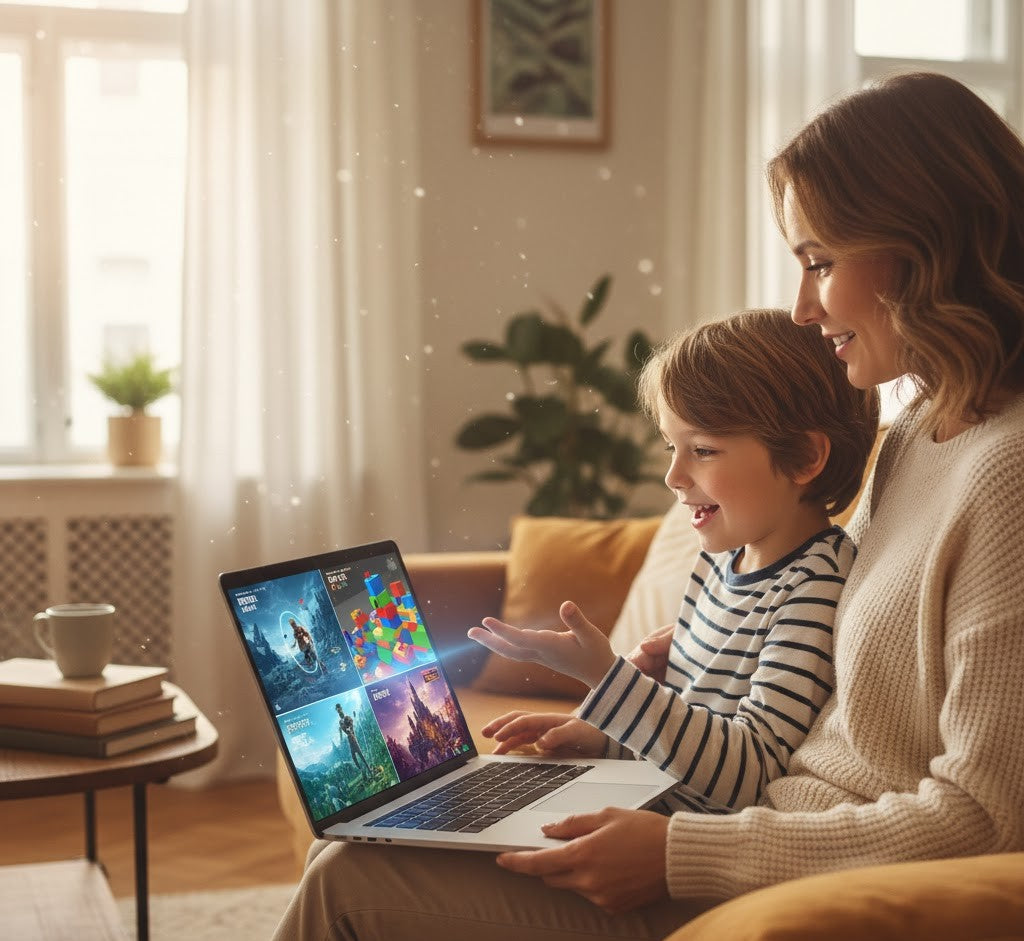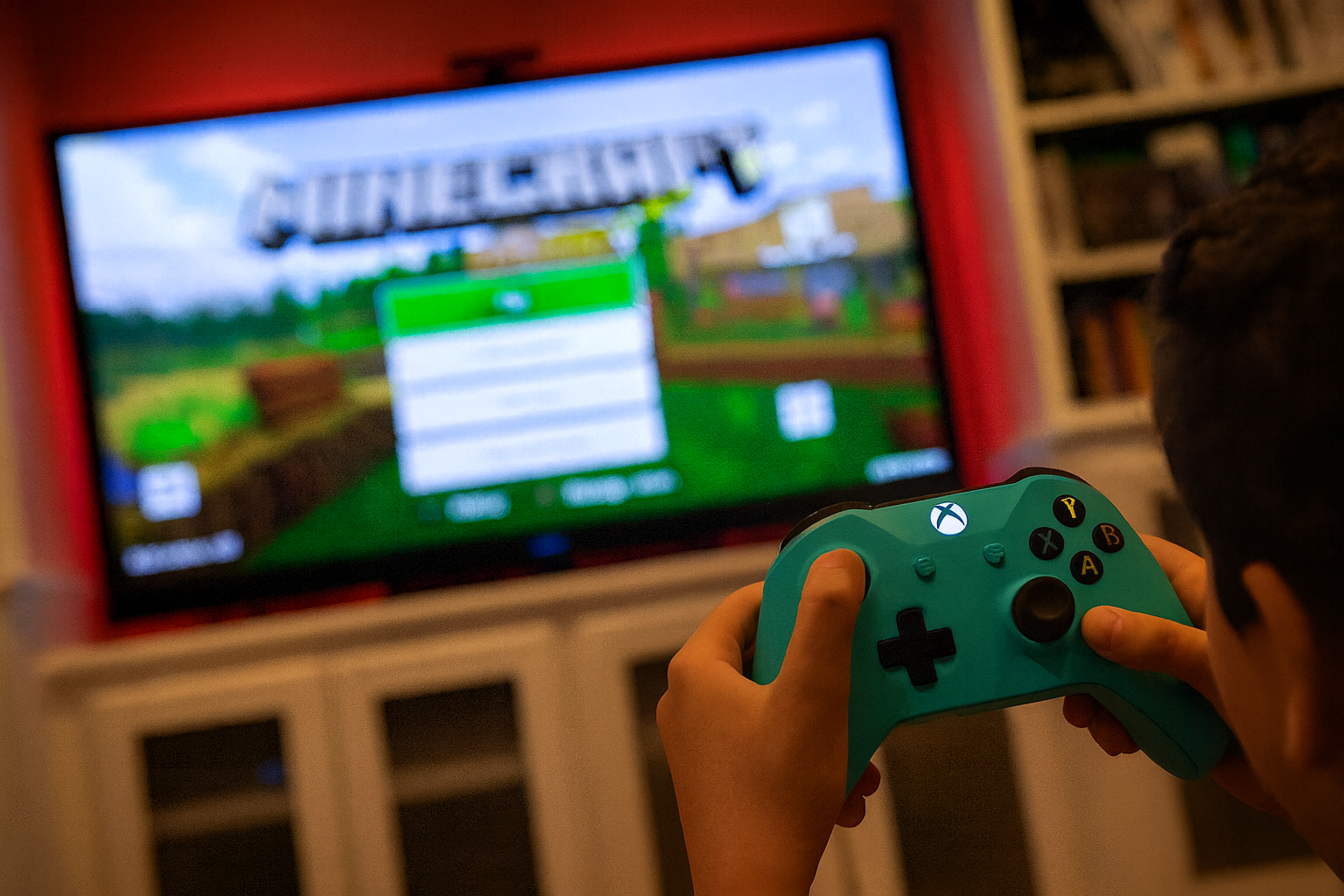Gaming and screen time
Gaming, or playing video games, is popular among many children and teens. Sometimes so much so that it can be hard to get them to do anything else. Discussions about when to play video games or for how long are probably not uncommon if your child loves gaming.
Kids play these games on computers, gaming consoles, iPads, or phones. They can range from simple and fun solitaire puzzles to complex strategy games with multiple players. For many children, as they get older, gaming becomes a hobby and an interest beyond just playing the game.
Gaming can be a significant part of kids’ social lives and the center of their interaction with friends, not just on the screen, but outside the game as well, providing inspiration for play and conversations.
With gaming becoming an all-consuming interest and social activity, managing gaming time for kids can be an ongoing struggle, and parents often wonder how much video game time is healthy.

Setting rules around video game time limits by age is advised to ensure we follow screen time guidelines that suit our child’s developmental stage and needs. Even though we make sure that what’s on the screen is educational and child-friendly, spending time in front of the screen can rob children of valuable real-life interactions and activities.
Especially young children depend on exploring and understanding the world through their senses in first-hand interactions with their surroundings, not through screens. They need to interact with their caregivers to help them process their impressions and to regulate their emotions and reactions to what they experience.
For this reason, it is not advised that children under the age of two spend any time on screens at all, and that screen time is increased gradually as the child matures.
Video game time limits by age
These are recommendations for video game time limits by age based on research and official Danish video game screen time guidelines for children during their free time:
- 0-2 years: No screen time or games are recommended for this age group.
- 2-4 years: Maximum one hour of screen time, including other screen activities besides games, and always with an adult nearby. Make sure you pick the games for your child to ensure they’re child-friendly, slow-paced, and commercial-free.
-
5-17 years: 1-2 hours, depending on age and activity. Get to know the game your child is playing. This way, you can better assess how to set suitable screentime limits and know what to be aware of when your child is on the screen, including the appropriate safety measures for their age.
Games can be fun, social, educational, and worth the time spent on screens. However, the concern around gaming stems, rightfully so, from the fact that many children spend too much time on screens, which can affect many areas of their lives negatively. No matter how good and beneficial a game is, the issue with excess screen time is that children are not doing anything else when they're on screens.
We must be mindful of creating a balanced life for our kids and check in with ourselves to understand what that balance looks like for our child. The key is to balance the quality, benefits, and purpose of the game with valuable physical activities and relationships outside the game, so our kids can enjoy their hobby healthily.
Gaming is more than just screen time
Setting guidelines around gaming is much more than limiting screen time. When we have a child at home who loves gaming, we must make an effort to understand the games they play. First of all, to assess if they are suitable for our child, but also to understand what’s great about our child’s favorite game and how it’s played.
This way, we are better equipped to have meaningful conversations with our kids about their favorite online activity.
When parents think of gaming, they might think of kids sitting alone and passively in front of a screen, engaged in repetitive, meaningless activities that might have an element of violence, and in the long run, will be harmful.
In reality, depending on the game, gaming can be much more dynamic and multifaceted. Children aren't just playing games - they are often engaging with a world that offers a variety of learning and social opportunities, and it doesn’t have to be violent at all. There can be many positive effects of gaming on children, too.
Gaming doesn't have to be a solitary activity, either. Many games are played with friends, in teams, one-on-one in a competition, or sitting next to each other, taking turns, sharing a screen. Gaming can provide a space for kids to bond and nurture their friendships, even if they’re not playing directly together or even being physically next to each other.
In addition, the story of the game often fuels conversations or imagination when playing with friends outside the game. Many young gamers also watch tutorials or recordings of other gamers' gameplay to learn about their favorite games, follow popular gamers, or improve their skills as an extension of their gaming experience.
Gaming can be a platform for developing strategic thinking and teamwork. Often, games require players to think critically, solve problems, and work with others to achieve shared goals. Whether they’re strategizing in real-time or collaborating with a team, gaming can help children hone important cognitive and social skills.
Additionally, some games have been developed for a specific educational purpose, which is why you can also find educational video games for children, created to help kids who benefit from alternative ways of learning. Cognitive development and video games don’t have to work against each other. When choosing the right games within a healthy framework, there can be many benefits of gaming for kids.

To KNOW and not just say NO
Screen time discussions are often rooted in a concern for children's health and well-being. Parents and experts worry about the potential consequences of excessive screen use - how it will impact concentration, sleep, physical activity, and overall development.
However, as our kids get older, and we might not be aware of every single game they are playing, it's important to recognize that the issue of screen time also has a lot to do with what’s on the screen and not just the amount of time.
Gaming is often labeled as unproductive or even harmful, and can be if our kids get their hands on the wrong games, but often it is not. There can be much more to this activity than we think. If we look a bit closer, harmful content and inactive hours in front of a screen are not always the case.
It’s easy for us to fall into the trap of simply saying “no” or cutting screentime short, thinking that gaming is bad for our kids and less is better, without fully understanding what’s happening on the screen.
Setting limits on screen time should come from a place of knowledge, not fear. We shouldn’t disregard our concerns about gaming, but we should be aware of the nuances and look closer at what our child is into, not just assume that it is bad for them.
Understanding children's gaming interests
Before we decide how much time your child can spend on gaming, we need to understand what’s happening on the screen, the content, the purpose of the game, and how a specific game affects our child.
Additionally, the quality of the games available for kids varies greatly, so it is important to pay attention to what they are doing on the screen and if it's beneficial or even harmful. We must find a way to stay engaged with our kids’ online activities even when they grow older, for example, by having regular open discussions about the games they play.
Not all games that our kids play are good for even a minimum amount of time, while other games might need more time for the players to plan with their team, carry out their mission, or see the results of their focused, complex work.
This is why it is a good idea to get to know the game and to discuss screen time limits with children, to know what works for the specific game your child is playing. Talking to kids about screen time includes learning about their favorite game to assess the quality of the game ourselves and understand the important aspects of the game.
Some games have short, intense levels, while others are slower, multiplayer games played with friends revolving around time-consuming strategic planning and cooperation to carry out a mission. Understanding the game is the first step to setting screen time limits that will last and make sense to our kids.

Checklist on what to KNOW when setting rules around screen time
Age-appropriate screen time
Check screen time recommendations for your child's age and assess the boundaries and framework needed to ensure a balanced life with time for other activities.
Get to know the game
Try the game or watch your child play. Assess the quality of the game and consider whether it is appropriate for our child's age and maturity level, and if there are any associated risks or safety issues to consider. Check in to understand what your child loves about the game. This is the best basis for meaningful discussions around future screen time rules.
Adjust screen time rules and frequency to the specific game
Are there team commitments, conversations, battles, or levels to complete that should be considered when agreeing on screen time rules? Some games are okay to play for a short time daily, while others might need longer screen time on specific days only.
Some games can easily be completed within a fixed time, while others might need a more flexible buffer zone to wrap up battles, missions, or other team commitments.
Independence or support in managing screen time
Agree on realistic rules around managing screen time. Acknowledge that leaving a game can be difficult, even for adults. Check in with your child about how much support they need in managing screen time themselves, and in what way they will need help keeping track.
Post-game pickups
Be aware that there can be conflicts, conversations, or big accomplishments needing extra attention after screen time ends. Like any other social interaction or sport, kids need us to check in and hear how it went. Don’t end every game with a conflict or complaint around the time spent online; instead, show an interest in how the game went, just like you would if they came home from a football match. Leaving the game, excited to share their experience with you, can be a game-changer in your screen time issues.
Be aware of offline issues
If a child is particularly drawn to the virtual world, assess whether there's a healthy balance between their online and real-life relationships. Your child may need your help solving problems outside the game. At times, online life and screens can become an escape from boredom, loneliness, or other issues.
Finding balance in the real and virtual worlds
It’s crucial to make sure your child is able to balance their online and offline lives. Gaming can be a positive outlet. However, it’s important to ensure that it’s not being used as an escape from real-life challenges or something they turn to simply because they don’t know what else to do.
Encouraging offline activities for kids can be necessary if they don’t actively seek them out. We have to make sure there is still time for physical activity and spending time with family and friends.
Some kids might also need to be reminded that there are other activities for entertainment than screens. Friends can get stuck in the habit of only playing video games and forgetting what else to do together. For this reason, we sometimes have to encourage our kids to spend time with friends offline, too.
If your child is heavily drawn to the virtual world, take time to examine their real-life relationships and activities, and check if they are maintaining friendships and interests outside of gaming. Some kids can use gaming to avoid dealing with issues in school, friendships, or family life. If so, it’s better to focus on those underlying problems and work towards solutions offline.
Concerns around screen time should not only be focused on the amount of time spent gaming, but also on why a child is drawn to it in the first place. A healthy balance between virtual and real-life activities is key to a child’s well-being.
What helping kids find balance looks like:
- Providing fun screen time alternatives for children to prevent them from choosing screens simply out of boredom
- Joining them in playing their favorite game to combine quality time and show an interest in what they love to do.
- Balancing screen time and physical activity off the screen to keep the body strong and healthy
- Promoting healthy screen habits by being a role model and leading by example
- Monitoring and reducing screen time for better sleep, time with friends and family, and other activities when needed
- Making sure there is a balance between your child's online and real-life friendships

How to solve the challenges around screen time
Conflicts and screen time rules around gaming, unfortunately, go hand in hand in many families. Some parents take on the fight while others give up; either way, something needs to change to make sure healthy habits and a peaceful family life aren’t lost in the struggles.
There can be many reasons for constant disagreements and issues around screen time. Finding out what triggers the conflicts can be a great start to solving them. The best way to find out is to find a peaceful moment to check in with your child and understand their perspective.
Often, without wanting it, we might have contributed to the conflicts by letting a situation get out of hand and not intervening sooner. Part of our frustrations with the excessive time spent in front of screens can then be with ourselves, for not handling the situation better.
We can still turn it around. We just have to be mindful of not projecting this frustration onto our kids, blaming them for our bad choices. In the end, managing screen time around games is too big a responsibility for many kids to handle on their own.
When addressing screen time issues with our kids and supporting new habits, we have to be mindful not to bring our frustration with ourselves into the situation to fuel a potential conflict.
When looking for solutions for excessive screen time in kids’ daily life, here are a few aspects of gaming screen time challenges to consider.
1. Are the rules fair?
Unlike some video games, many online games can't be paused or stopped without serious consequences for the team. Games like Fortnite or Counter-Strike are often played in real-time, with live teammates and opponents. Asking your child to turn off the game in the middle of a match or 10 minutes before the end will most likely cause frustration or lead to conflicts.
Other games consist of complex levels that take hard work and concentration to complete. Being forced to leave the game minutes before the end of a level that you worked hard to reach can easily be the reason for conflict.
Children value fairness and respect, and cutting off a game without warning can feel disrespectful to their commitment and their relationships with other players. It can be compared to being called home from an important football game 10 minutes before the end. To some kids, it can feel like their hobby is not valued or understood by their parents, which can lead to further distance and a lack of responsiveness to rules or unwillingness to cooperate.
If you frequently experience big conflicts over gaming time, be curious and talk with your child to find the reason. They may feel that their gaming time isn’t respected or that you don’t understand the nature of their games. In that case, you can change your approach to work together towards an agreement on a better routine for ending a game.
2. Stimulating games that retain the attention
Games are often purposely designed to be overly stimulating and retain the player as long as possible. Other kids are simply naturally more drawn to games and can find it very hard to turn off the screen by themselves.
If you sense that your child has this issue, setting clear boundaries and helping them when it’s time to turn off the game can be necessary. Make sure you help your child pick out games that are better for them as well. Identify the difficult part in letting go of the game, and agree on how you can help them in this process to make the transition easier.
Acknowledge that it is hard, and accept that it might never be easy for them. However, taking off the blame and criticism for their mistakes and struggles with turning off the screen can help the motivation, as well as agreeing on consequences or ‘rewards’ for succeeding.

3. Burnout
Strong reactions after being asked to stop video games can simply be the result of too much time on the screen. Spending long hours in front of the screen, especially after playing highly stimulating games, can be hard for the brain to transition from. A lack of fresh air, exercise, sleep, social activities, and maybe not eating or drinking enough doesn’t help.
The mind and body might not be in the best condition to handle frustration, and this can easily lead to conflict. If this seems to be your issue, your child needs you to step in and help them regulate their screentime. It could also be that it is necessary to pick out better games if you find that the games they play are too stimulating and stressful.
4. Gaming as an escape or addiction
Alternatively, some kids may be using gaming to cope with difficulties in life. In case of video game addiction, kids can disappear into the gaming world as a way to cope with difficult emotions and situations offline.
If you suspect your child is showing signs of video game addiction, then you need to reach out to your healthcare provider for professional help and evaluation. Open conversations about their feelings and challenges in school or at home can help avoid using video games as a coping mechanism in difficult situations.
5. Lacking offline friends and activities
Kids crave friendships and valuable connections. Some kids might seek those out online to the extent that they have stronger ties to the gaming community than in real life. If this is the case, they will naturally want to spend as much time online as possible.
Make sure to help your child build friendships offline, too, and work out how to solve the issue with loneliness outside the game. Some kids benefit from seeking out physical communities formed around a gaming hobby, as a way to enjoy their gaming interests in an offline setting and meet friends outside the game. And remember to nourish offline activities, too. Have a list of fun things to do together, and carve out time to cultivate offline hobbies and interests.
6. Projecting our frustration onto our kids
Sometimes parents contribute to creating unhealthy screen time habits for their children. Often, we allowed a bit more time on the screens than we would have liked simply to keep our child occupied and entertained, leading us to be frustrated and blaming ourselves.
Bringing this frustration into screen time conflict and blaming our kids for our mistakes will only fuel the fire. Acknowledging our part in unhealthy habits and focusing on looking ahead, instead of taking our frustration out on our kids, will make any screen time discussion easier.

Setting screen time rules together
The best approach for creating family screen time agreements around gaming is to involve your child in setting rules. Talk about what makes sense for the types of games they play. By understanding the game’s mechanics, you can create a plan that works for both of you.
For example, you might agree on a set time for playing certain games, or the number of levels to complete for another game. Other games might need more flexible time to finish a match or mission.
Additionally, we must take a holistic view of our child’s life to make sure they have time for school, physical activity, family, and socializing, too. Together, we can identify what other parts of their life are important to them besides gaming to keep them happy and healthy, and let them know that it’s your job to make sure that screen time doesn't get in the way.
Negotiating screen time limits with children might not be the easiest part of parenting, but these are ways to make it a bit easier. Collaborative screen time rules for families mean involving children in screen time decisions.
Learning about the games they play and listening to their needs will make it more likely that they will be open to listening to you and the reasons behind regulating their time on screens. Conversation and mutual respect are the best foundation for making rules and habits that last, as well as dealing with mistakes and breaches in the future.
A balanced approach to screen time
Sometimes we need to look closer at the games our kids are playing and adopt a more nuanced perspective on this screen activity. Gaming can be a learning experience and also a very social activity.
However, like any hobby, it’s important to ensure that it doesn’t overshadow other aspects of life and that we find a balanced approach to integrating screen time into daily routines. Getting involved in understanding what children are playing, who they’re playing with, and why they enjoy it is key to making informed decisions about balanced screen time for children.
Creating fair and healthy screen time habits for kids includes approaching the issue with knowledge, insight, communication, and empathy. This is the best foundation for creating a healthy balance between our children’s virtual and real worlds that will make sense to them, too.

10 parenting tips for managing screen time
To sum it all up, we put together our best screen time management tips for parents here. Use this list as inspiration for creating a balanced life with gaming for kids.
-
Get to know the game: Get to know the games your child is playing. Try to play them yourself or sit next to them to get a feeling of what the game is about and how it’s played. Make sure they are age-appropriate, and check if there are any safety or health concerns to consider.
-
Understand the benefits: Understand that gaming time can be much more than playing games; sometimes it’s practicing social skills, strategic thinking, teamwork, and much more.
-
Ensure a balanced social life: Ensure gaming doesn’t replace real-life relationships and activities or steal time from other essential daily tasks. Be aware of screen time limits that suit your child's age and development.
-
Check for other underlying issues: Learn why your child is drawn to gaming. Sometimes it can be an escape from underlying issues offline, like boredom or loneliness, that they will need help dealing with. If you suspect signs of addiction, seek qualified help from your doctor or healthcare provider.
-
Create fair screen time rules: Adjust the screen time rules to fit the game. For example, agree on a number of levels to complete, or incorporate a buffer time for games that need time to wrap up conversations or battles.
-
Pay attention and be involved: Show an interest in your child's hobby, for example, by asking how the game went. Sometimes, there are hard-earned victories to celebrate or in-game conflicts between friends or other gamers to resolve. Gaming can be a great way to bond with your child.
-
Create new habits together: Discuss screen time with your child. Collaborate with your child to create reasonable limits for everyone in the family. Get your child's input on creating meaningful screen time rules and a balanced daily life. This can help avoid power struggles and ensure both feel heard and understood.
-
Be responsible for your past choices: Acknowledge your own responsibility in contributing to unhealthy screen time habits for your child to avoid projecting your frustration onto them. Often, parents allow more screen time to avoid conflicts or interruptions, leading to self-blame and frustration. Leave blame and shame out of your screen time discussions and focus on looking ahead to the new habits you want to create.
-
Support offline activities: Come up with a list of fun things to do that don’t involve screens, so gaming doesn’t become the only activity your child can think of. Sometimes kids just need to remember all the fun alternatives. It might take a bit of time, encouragement, and support to get into new habits. Doing activities together helps a lot.
- Be a supportive role model: Be authentic and acknowledge that managing screen time is hard for both kids and adults. Compliment your child when they succeed and support them when it’s difficult. Make sure you pave the way for healthy habits by managing your own screen time and online gaming habits, and be open when you find it difficult yourself.





